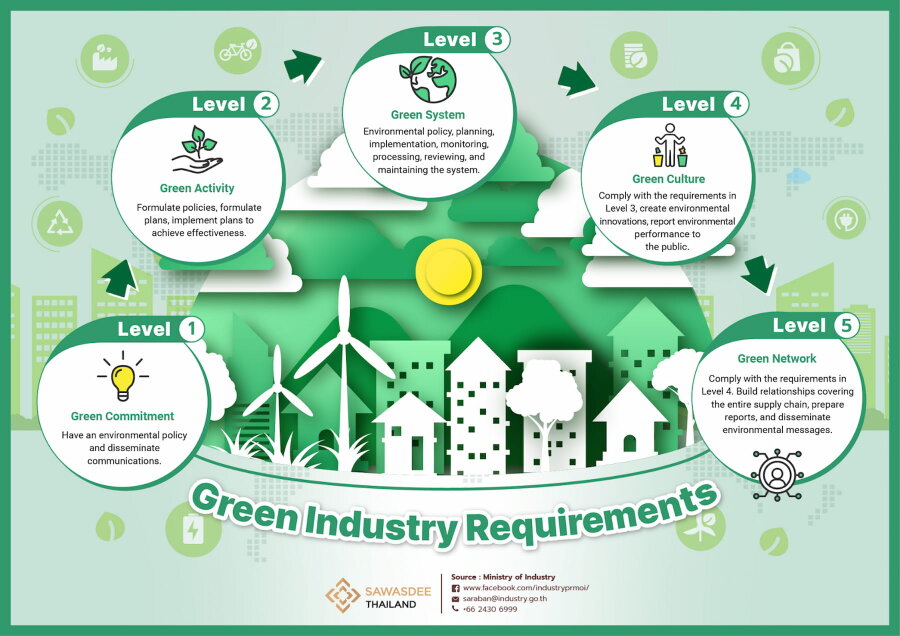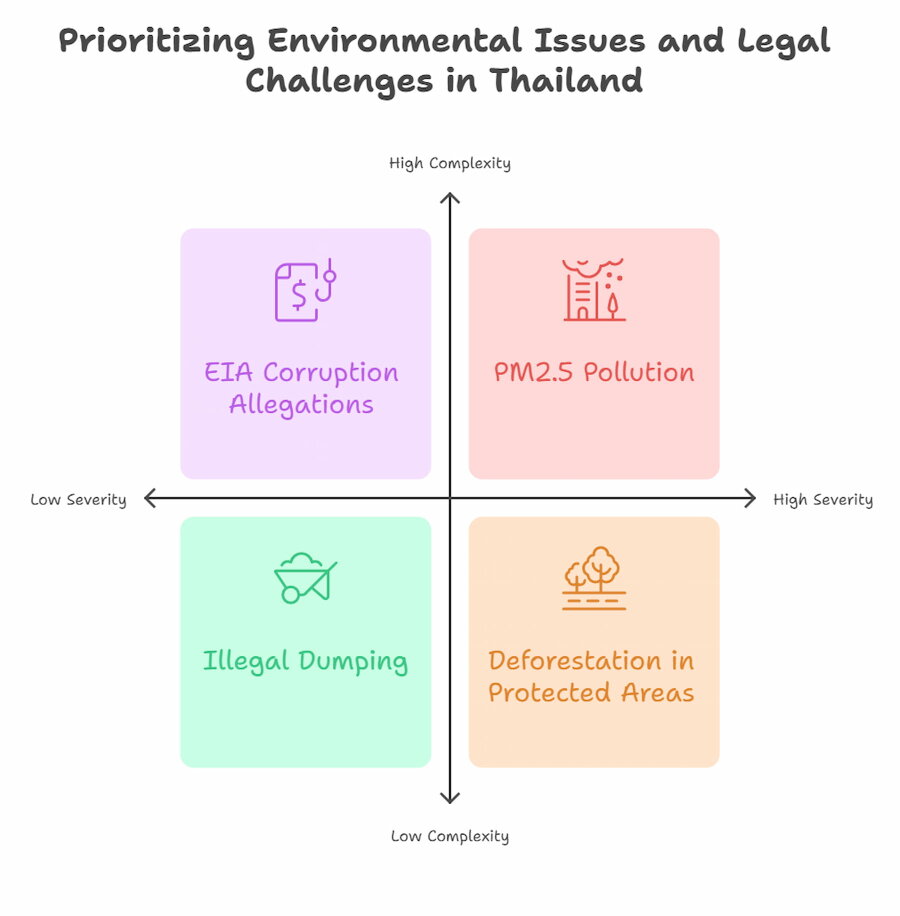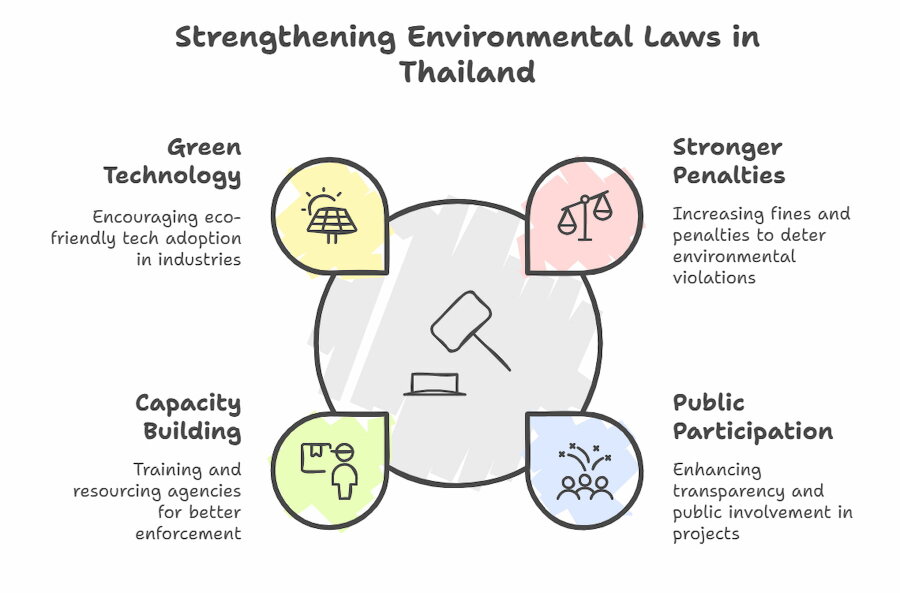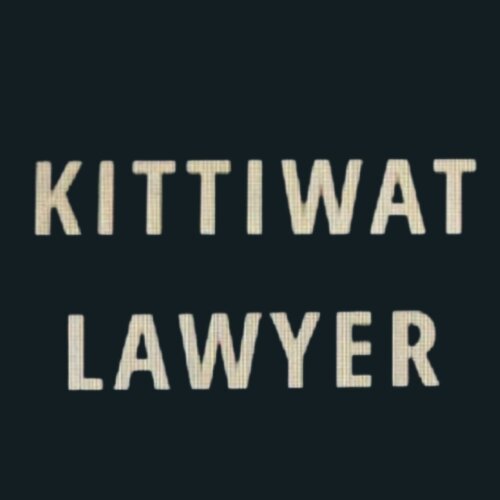As Thailand confronts growing issues with pollution, deforestation, climate change, and unsustainable industrial activities, environmental control in the nation has become ever more relevant. Navigating the complexities of Thai environmental regulations calls for a thorough awareness of the legal framework, enforcement tools, and continuous difficulties for attorneys and interested parties.

Overview of Thailand's Environmental Regulatory Framework
The Enhancement and Conservation of National Environmental Quality Act (NEQA) B.E. 2535 (1992) essentially controls Thailand's environmental policies. The basis for handling resource management, environmental preservation, and pollution control is laid by this legislation. The main government agencies supervising environmental compliance consist in:
- Policy development and supervision falls to the Ministry of Natural Resources and Environment (MNRE).
- The Department of Pollution Control (PCD) works to reduce pollution from urban, agricultural, and industrial operations.
- Under supervision of environmental impact assessments (EIAs) for development projects, the Office of Natural Resources and Environmental Policy and Planning (ONEP).
Important Environmental Regulations in Thailand
Environmental Impact Assessments (EIAs)
EIAs are necessary for large-scale projects that might possibly affect the environment. Industries such as mining, petrochemicals, and infrastructure development must submit an EIA report for clearance.
Key Legal Issues:
Ambiguities in EIA Criteria: Critics believe that certain standards for needing an EIA are excessively lax, enabling ecologically hazardous projects to evade examination.
Lack of Transparency: Public access to EIA reports is typically restricted, creating questions about accountability.
Corruption Allegations: The EIA approval procedure has sometimes been accused of unfair bias or undue influence by interested interests.

Air Pollution and Emission Standards
Air quality is governed by the Factory Act B.E. 2535 (1992) and the Clean Air for All Act, which sets emission limitations on companies and automobiles. Despite these steps, Thailand routinely confronts high levels of PM2.5 pollution, especially in metropolitan areas like Bangkok and Chiang Mai.
Key Legal Issues:
Enforcement Gaps: While emission standards exist, monitoring and enforcement remain inconsistent.
Industrial Pollution: Factories in some regions fail to adhere to emissions limits due to weak penalties or corruption.
Waste Management and Recycling Laws
Thailand creates about 27 million tons of waste yearly, yet only a quarter or less is recycled or disposed of sustainably. The government has established regulations under the Public Health Act B.E. 2535 (1992) and other frameworks to handle the rising waste issue.
Key Legal Issues:
Illegal Dumping: Cases of hazardous waste being illegally deposited in uncontrolled regions are prevalent.
Recycling Challenges: While rules promote recycling, poor infrastructure and public awareness hamper progress.
Water Pollution and Marine Ecosystems
Thailand's streams and marine habitats endure significant pollution from agricultural runoff, industrial discharge, and untreated wastewater. Key rules addressing water pollution are the Water Quality Management Act and the Fisheries Act B.E. 2558 (2015).
Key Legal Issues:
Inadequate Treatment Facilities: Many municipalities and companies lack suitable wastewater treatment facilities, leading to direct discharge into rivers and seas.
Overlapping Jurisdictions: Multiple government entities control water resources, generating inefficiencies and conflicts in enforcement.
Marine Resource Degradation: Pollution harms marine biodiversity, especially coral reefs and fisheries, harming coastal lives and tourism.
Notable Cases:
The Samut Prakan oil disaster in 2022 revealed vulnerabilities in Thailand's marine pollution response protocols, resulting in a greater public demand for stronger supervision and speedier cleaning operations.

Deforestation and Land Use Policies
Deforestation has been a long-standing issue in Thailand, driven by illegal logging, agriculture, and urbanization. The National Reserved Forest Act B.E. 2507 (1964) and the Forests Act B.E. 2484 (1941) aim to protect Thailand's forests, but enforcement remains a challenge.
Key Legal Issues:
Encroachment on Protected Areas: Despite legal protections, deforestation continues in national parks and wildlife sanctuaries, often for plantation agriculture or tourism projects.
Land Use Conflicts: Disputes between local communities, developers, and government agencies over land rights and resource use are common.
Weak Penalties: Existing penalties for illegal logging and deforestation often fail to deter offenders.
Proposed Reforms:
Community Forest Laws: Encouraging community management of forests to promote sustainable practices and reduce conflicts.
Technology for Monitoring: Using satellite imagery and AI to detect illegal logging and encroachments.
Climate Change Commitments and Challenges
Thailand has vowed to decrease greenhouse gas emissions as part of its responsibilities under the Paris Agreement. The Climate Change Master Plan (2015-2050) includes methods for mitigation and adaptation.
Key Legal Issues:
Lack of Binding Regulations: Climate policies are frequently aspirational rather than legally enforced, making compliance optional.
Energy Transition Barriers: The dependence on fossil fuels and delayed adoption of renewable energy limit Thailand’s progress toward emission reduction objectives.
Vulnerable Populations: Communities in flood-prone and drought-affected regions suffer high risks owing to poor climate adaptation strategies.
Recent Developments: The implementation of carbon credit trading systems and tax incentives for renewable energy projects is a step forward, but more comprehensive legislation is required to enforce climate targets.
Challenges in Enforcement of Environmental Laws
Fragmentation of Regulatory Authorities
Multiple agencies, including the Pollution Control Department, the Department of National Parks, and local governments, share responsibility for enforcing environmental laws. This often leads to overlapping mandates and inefficiencies.
Corruption and Lack of Transparency
Corruption remains a significant barrier to effective enforcement, with some officials accused of accepting bribes to overlook violations.
Public Participation and Awareness
While Thai laws compel public engagement for significant projects, these procedures are typically cursory or exclude underprivileged people. Public awareness efforts and improved openness are important to overcome this gap.
The Role of International Agreements
Thailand is a party to many international environmental treaties, notably the Convention on Biological Diversity (CBD) and the United Nations Framework Convention on Climate Change (UNFCCC).
Key Legal Issues:
Implementation Gaps: While Thailand has signed these accords, integrating local legislation with international obligations remains a difficulty.
Cross-Border Pollution: Issues such as transboundary haze pollution from neighboring nations hinder enforcement attempts.
Community and Indigenous Rights in Environmental Protection
Local and indigenous groups in Thailand play a key role in conserving natural resources. However, development initiatives sometimes collide with traditional land rights and cultural customs.
Legal Protections:
Community Forest Act B.E. 2562 (2019): Recognizes the rights of local communities to maintain and profit from forests responsibly.
Constitutional Provisions: The Thai Constitution protects the right to a healthy environment and community involvement in environmental decision-making.
Challenges:
Land Disputes: Conflicts over resource access, notably in mining and agricultural zones.
Marginalization of Indigenous Voices: Limited inclusion of indigenous knowledge in policy-making processes.
Case Example:
The Khon Rak Ban Kerd group in Loei province successfully opposed a gold mining project, citing environmental and health impacts, illustrating the power of grassroots movements in environmental advocacy.
Role of Environmental Impact Assessments (EIAs)
Environmental Impact Assessments (EIAs) are a cornerstone of Thailand’s environmental regulatory framework. Required for projects with potential significant environmental effects, EIAs aim to identify, mitigate, and monitor environmental risks.
Key Legal Provisions:
Enhancing Enforcement: The Enhancement and Conservation of National Environmental Quality Act B.E. 2535 (1992) mandates EIAs for various industrial, infrastructure, and real estate projects.
Public Hearings: Stakeholders, including local communities, must be consulted during the EIA process.
Limitations in Practice:
Superficial Assessments: EIAs are sometimes rushed or inadequately conducted, undermining their effectiveness.
Conflict of Interest: Consultants preparing EIAs are often hired by project proponents, raising concerns about impartiality.
Weak Follow-Up Mechanisms: Post-project monitoring is often inconsistent, leading to unchecked environmental damage.
Recommendations:
Third-Party Reviewers: Engaging independent consultants to review EIAs for accuracy and compliance.
Stronger Penalties for Non-Compliance: Ensuring projects failing to comply with EIA recommendations face strict repercussions.
Litigation and Legal Remedies
Environmental litigation is gradually gaining traction in Thailand, thanks to growing awareness and advocacy by non-governmental organizations (NGOs). Key types of litigation include:
Class Action Lawsuits: Communities affected by industrial pollution often band together to seek damages.
Public Interest Litigation: NGOs file cases to hold corporations and government bodies accountable for environmental harm.
Challenges in Environmental Litigation:
Access to Justice: High legal costs and limited legal aid hinder affected communities from pursuing lawsuits.
Judicial Expertise: Thai courts are still building expertise in handling complex environmental cases, which can delay proceedings.
Case Studies
Mae Moh Power Plant Case
The Mae Moh coal power station in northern Thailand has been a topic of litigation owing to its effect on local residents. Residents have successfully sued for compensation, illustrating the viability of legal remedies in addressing environmental damage.
Map Ta Phut Industrial Estate
This case involves industrial pollution from one of Thailand’s major industrial zones, resulting in serious health and environmental implications. It resulted in stronger environmental monitoring and heightened scrutiny of industrial undertakings.
Policy Recommendations for Strengthening Environmental Laws in Thailand
Stronger Penalties for Violations
Increasing fines and penalties for environmental violations to deter offenders.
Enhanced Public Participation
Improving transparency and ensuring meaningful public consultation for development projects.
Capacity Building for Enforcement Agencies
Providing training and resources to environmental agencies to improve monitoring and enforcement.
Promoting Green Technology
Encouraging industries to adopt environmentally friendly technologies through subsidies and tax incentives.

Corporate Social Responsibility (CSR) and Environmental Compliance
Many corporations in Thailand have adopted CSR initiatives to align with environmental regulations and demonstrate commitment to sustainable practices.
Legal Incentives for CSR:
Tax benefits for companies implementing green technologies or adopting sustainable practices.
Environmental, Social, and Governance (ESG) Reporting: Encouraged under the Securities and Exchange Commission’s guidelines for publicly listed companies.
Best Practices:
- Investing in renewable energy solutions to reduce carbon footprints.
- Partnering with local communities to restore degraded ecosystems.
Limitations:
Greenwashing: Some companies exaggerate their environmental efforts for marketing purposes.
Voluntary Nature: CSR initiatives are often not legally binding, limiting their impact.
Getting to Know Environmental Laws in Thailand
Navigating the legal landscape of environmental legislation in Thailand is complicated yet necessary for maintaining sustainable growth. Lawyers and stakeholders must keep educated about developing legislation and enforcement tools to solve environmental concerns efficiently. With stronger legislation, improved enforcement, and more public engagement, Thailand can reconcile economic expansion with environmental preservation.
If you would like to explore this topic further, why not connect with one of the many Thailand environmental legal specialists? You can send them a message for free on the Lawzana online legal platform.




